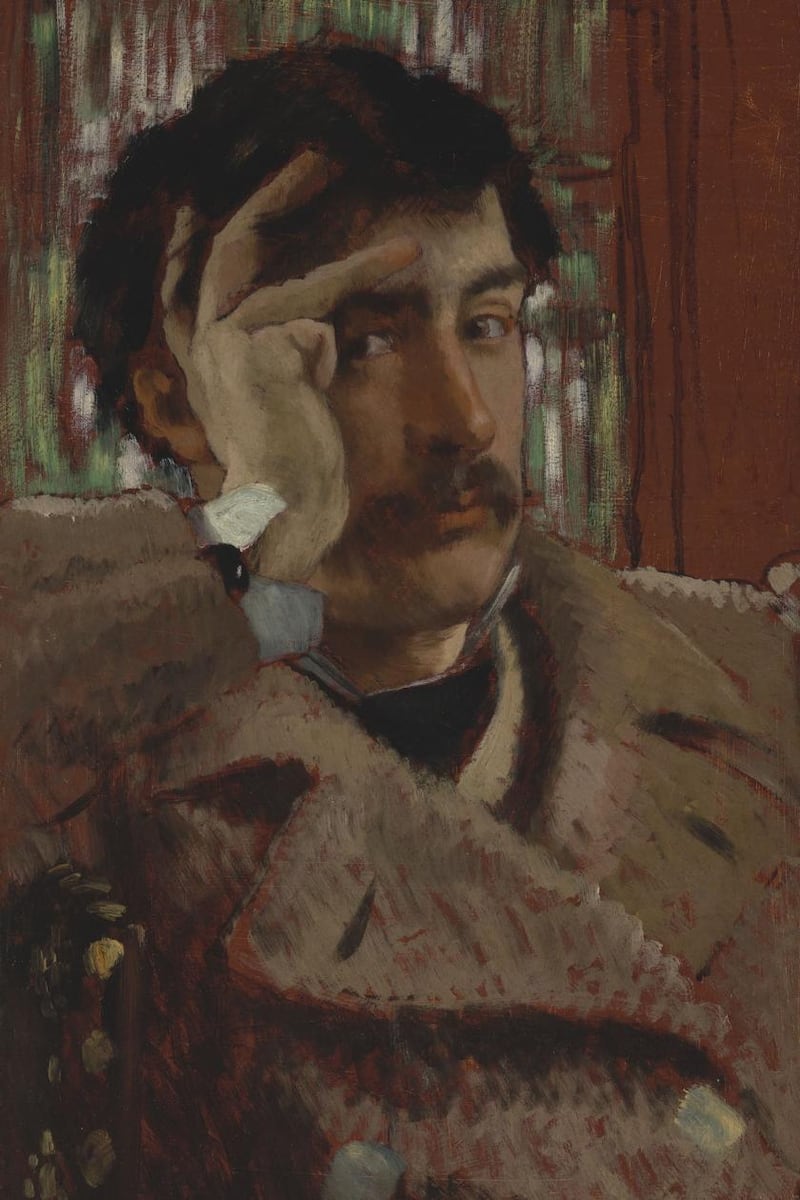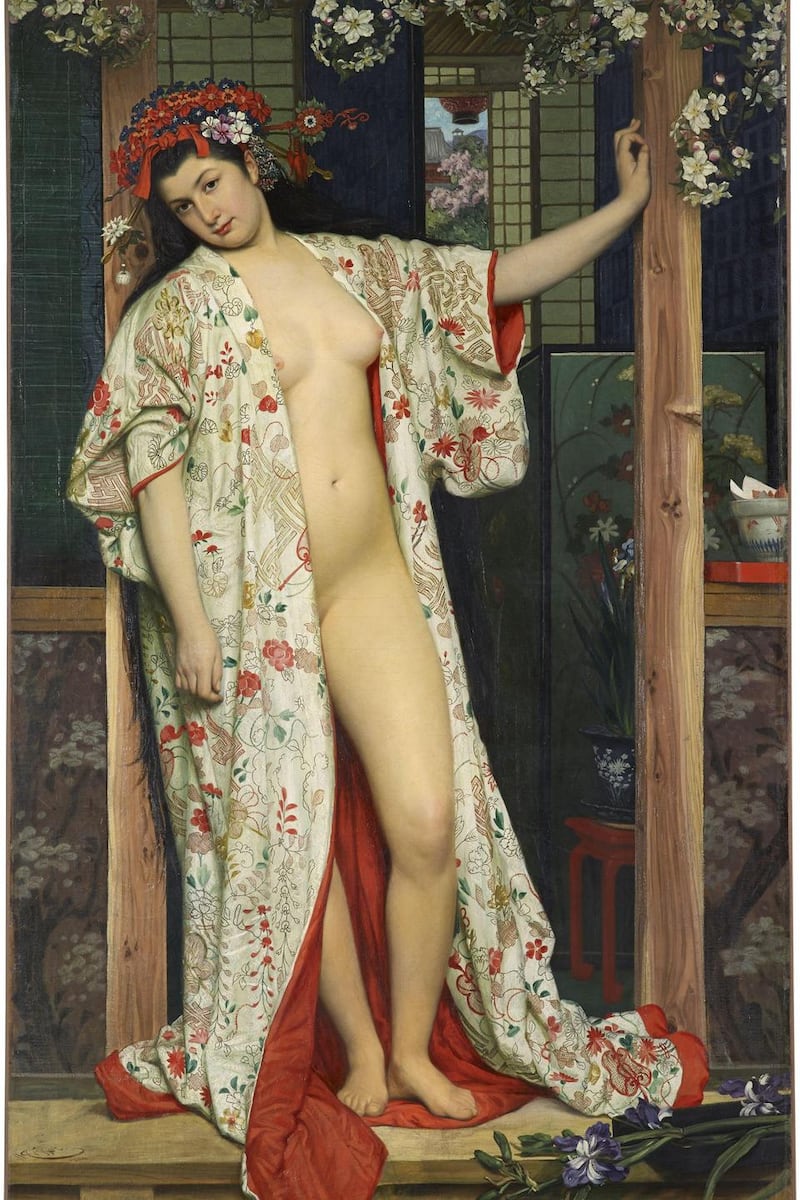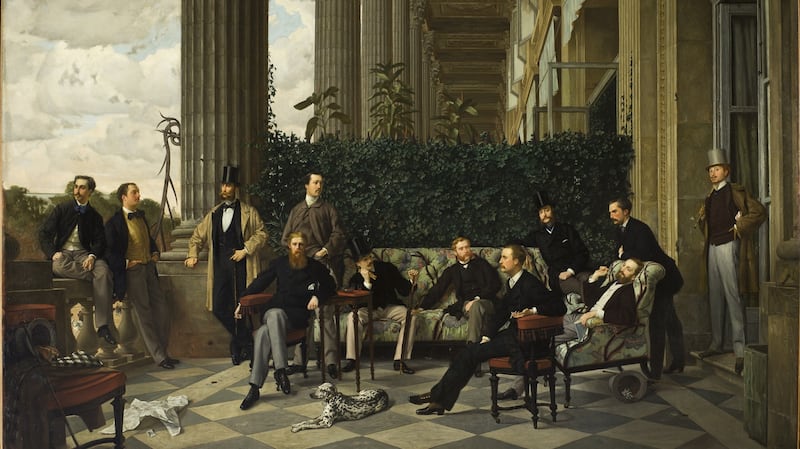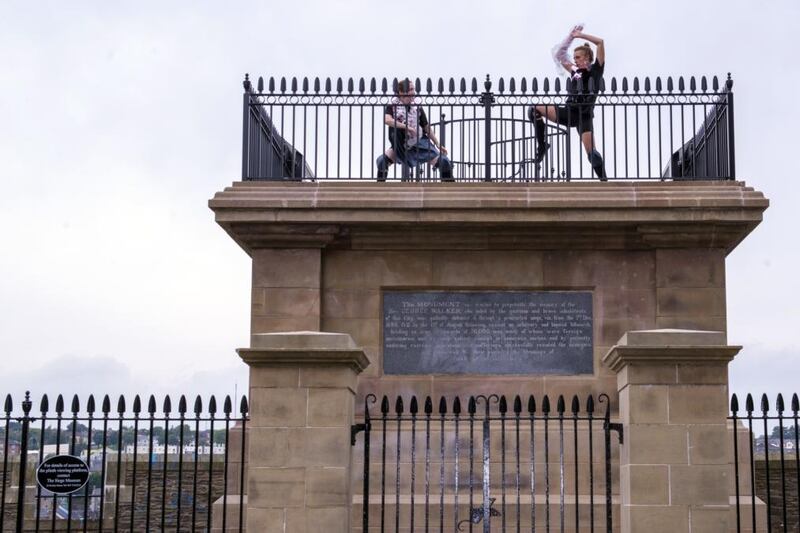A dozen men sit or stand on the terrace of the Cercle de la rue Royale, an exclusive club overlooking the Place de la Concorde. They are men of property and substance, captains of industry, symbols of the post-revolution alliance between the haute bourgeoisie and the aristocracy. Among them are four marquis, three counts, a prince and a baron. From their vantage point they literally dominate Paris.
James Tissot (1836-1902) captured the elegance and confidence of the French ruling class, from the toes of their well-polished shoes to their silk top hats. His mastery of perspective is impressive, the intricacies of décor and clothing dazzling. With photographic realism, he catalogues the tiniest details of foliage, the fringe on armchairs, the glint on sherry glasses and the checks on houndstooth trousers.
Tissot studied with the painters Jean-Hippolyte Flandrin and Louis Lamothe, both students of the great Jean-Auguste-Dominique Ingres. Tissot’s artistic lineage shows in his sumptuous rendering of clothing. The look and feel of fabric were in his blood, for his father was a textile merchant.
0 of 3

The look in Tissot's eyes may be interpreted as calm, mischievous, ambitious or amused
In a decade when Manet scandalised Paris with paintings of naked women, Tissot showed the Second Empire what it wanted to see: itself, in all its materialistic grandeur.
Manet and his followers concluded that photography made realism in painting irrelevant. Tissot saw the new technology as a useful instrument, not as a source of existential anguish. He declined an invitation from his friend Edgar Degas to show in the first Impressionist exhibition. In his day, Tissot was more successful than the Impressionists.
In 1866, Tissot received a medal from the Salon and built a mansion on what is now the avenue Foch. It was Tissot’s way of proving to his father that he, the prodigal son, had been right to become a painter. The Biblical story of the errant son was a theme he returned to often.
In a superb self-portrait, painted in 1865, a handsome young man with an intelligent face, dark hair and a shaggy moustache leans against his hand, three fingers splayed against his forehead. The look in Tissot’s eyes may be interpreted as calm, mischievous, ambitious or amused. The brushstrokes are free and loose, almost Impressionistic.
In an early sign of Anglophilia, Tissot changed his name from Jacques Joseph to James at the age of 11. Six years before he moved to London, his portrait of the Marquis and Marquise de Miramon and their children drew as much from Gainsborough and Reynolds as from Ingres.
French critics found Tissot too British, while the British thought him too French. During his decade in Victorian London, his paintings were criticised on moral grounds. The man who ogles women wearing transparent dresses in HMS Calcutta (1876) wears a wedding ring. In On the Thames, also painted in 1876, two women float through the docklands with a sailor. The navy was associated with loose morals, and the champagne bucket in the foreground seems to confirm debauchery.

A French woman masquerades as a geisha, her kimono opened to show small, round breasts and a waxed pubis
Like his friends Degas and Whistler, Tissot was a proponent of Japonisme. He collected Japanese kimonos and prints and learned to make cloisonné enamel pieces inspired by the Far East.
Tissot’s Japanese Woman in the Bath (1864) epitomises the French 19th-century fascination with Japan, and elicits mixed feelings about Tissot’s oeuvre. A French woman masquerades as a geisha, her kimono opened to show small, round breasts and a waxed pubis. But she is more kitsch than erotic, and leaves the viewer indifferent.
In contrast, Tissot’s engravings of the 1870 Prussian siege of Paris and his watercolours of a wounded soldier and Communards executed by the French government are powerful works of reportage.
Rumours circulated that under the Commune, Tissot was involved in the destruction of works of art associated with the fallen Second Empire. The defeat of the Commune may explain Tissot’s sudden departure for London in the summer of 1871. The theory that Tissot was a secret revolutionary is strengthened by correspondence with a friend in Paris whom he asked to check his police record.
Tissot returned to high society in his paintings of 1870s Britain. The Ball on Shipboard (1874), is to Victorian high society what his Cercle de la rue Royale was to 1860s Paris.
Among the guests are the Prince and Princess of Wales, Albert and Alexandra, and Tsarevich Alexander with his wife Maria, Alexandra’s sister. About 20 people are arranged in a diagonal line from right to left on the deck of the ship. A pair of dancers can be glimpsed through the stairwell, below deck. A canopy of brightly coloured flags shade guests from the sun. The cliffs of Dover loom in the distance.

Under the influence of the woman he called his Mavourneen, domestic scenes replaced society life in Tissot's paintings. He and Irishwoman Kathleen Newton, née Kelly, met in 1876, when he was 41 and she was 23.
The daughter of an Irish army officer stationed in India, Newton had fallen in love with Captain Henry St Leger Bury Palliser, a British naval officer, during her passage to India for an arranged marriage with a surgeon called Isaac Newton. The couple divorced without consummating their marriage. Kathleen’s daughter Muriel was born in 1871, her son Cecil George in 1876. Palliser was the father of Muriel. It is not clear whether Palliser or Tissot was the father of Cecil George.
Tissot was fascinated by Newton’s beauty, her Catholic upbringing and status as an unmarried mother. He described the five years during which she was his muse and model as domestic bliss.
In the painting titled October, the young Irishwoman looks over her shoulder, framed in a halo of dying chestnut leaves and beckoning the viewer to follow. Nothing is ever as beautiful as when it is dying, Tissot seems to say.
The Daily Telegraph savaged Kathleen as “a siren in black silk stockings and high heels” and warned Tissot that the sooner he abandoned such subjects, the better it would be for his reputation.

A vision of Christ led Tissot to devote the last 15 years of his life to illustrating the Bible
When Kathleen died of tuberculosis at the age of 28, Tissot sat beside her coffin for four days, then returned to France. He painted a series titled Women in Paris, dedicated to the modernity of women on the boulevards, in shops, entertainment and society.
In Chariot Women (1883-85), Tissot showed modern-day amazons dressed in spiky crowns and dresses made of gold scales, driving horses around an amphitheatre built from glass and steel girders, architecture typical of the late 19th century.
Women in Paris was a flop. Tissot was obsessed with communicating with the spirit of Kathleen Newton. He hired a medium and was convinced she visited him during a seance in May 1885. Later that same year, a vision of Christ led Tissot to devote the last 15 years of his life to illustrating the Bible. He travelled three times to the Middle East to research landscapes and costumes.
Tissot’s two-volume Life of Christ became a worldwide bestseller that influenced film-makers including DW Griffith, Cecil B DeMille and Martin Scorsese.
The Tissot retrospective, the first in France in 35 years, was delayed for two months by the Covid-19 epidemic. Visitors must reserve in advance and are required to wear masks. Museum-going has become much more pleasant because there are no longer crowds in French exhibitions.
James Tissot, the Ambiguous Figure of Modernity is at the Musée d’Orsay in Paris until September 13th, 2020















